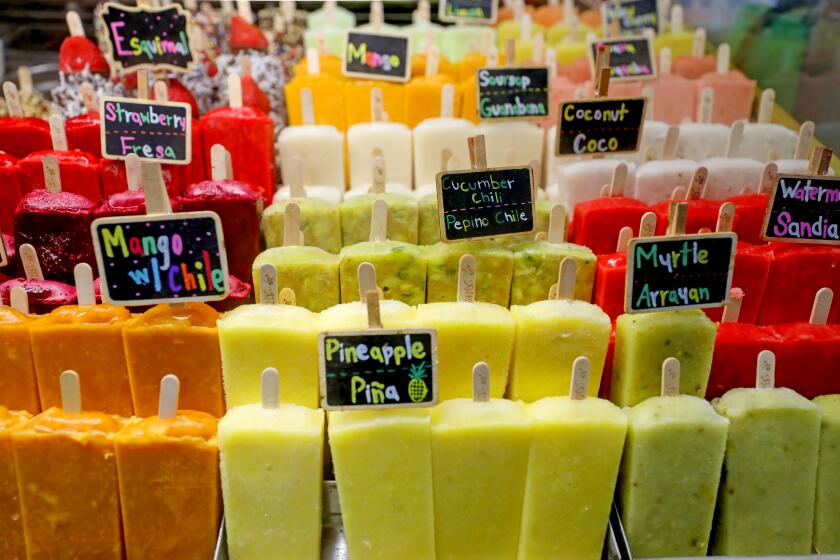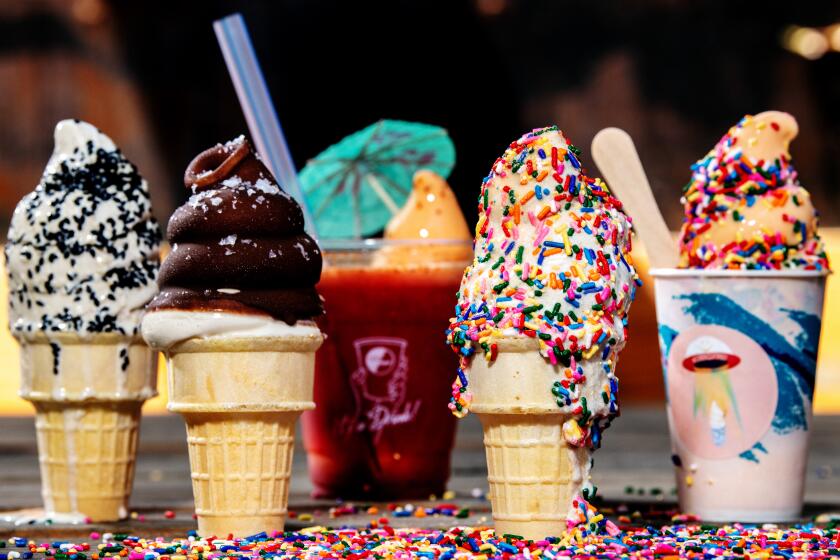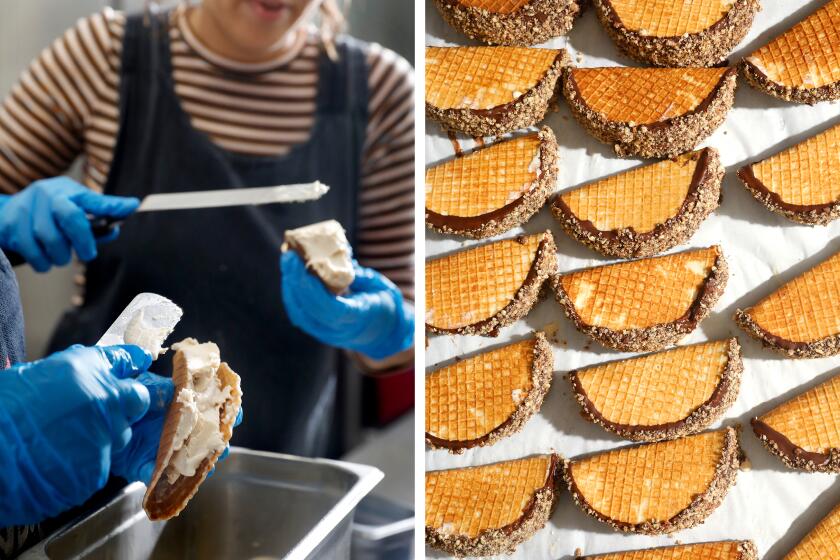- Share via
School is back in session. It’s that time of year when the unrelenting sun beats down on the black asphalt playgrounds of Los Angeles and through the classroom windows that stand between children and their after-school freedom. You’re a kid again, and after sweating through your classes, you burst out of the school gates to look for the “ice cream man.”
Then you hear it. That glorious, slightly muffled, slightly off-tune chime that only means one thing: An ice cream truck is coming. Your heartbeat pounds through your eardrums as you round the corner onto your street and bolt back into your house.
“He’s here! He’s here!” you call out to your parents, hoping that’s enough to justify your commotion and the $5 bill you swipe off the kitchen counter.
“Watch for cars!” they call from the other room.
When you crash back out of your front door, you realize that, like a siren song out at sea, the tune playing from the speakers of the neighborhood ice cream truck has already lured a herd of children waving their dollar bills in the air. You see your best friend already clamoring toward the front of this herd and, smiling, you join in.
The ice cream man — and not only ice cream men but also ice cream women — is a beloved figure who shoulders as much lore as the tooth fairy. Like the enigmatic fairy, the title of “ice cream man” is merely a guise. Underneath that guise, there are people working day after day to provide for themselves. For those who lack neighborhood scoop shops, they offer a community service, bringing a welcome dose of refreshment to L.A. communities on baking-hot afternoons, block by block.
As children, we were too preoccupied with the frozen desserts stocked inside of ice cream trucks — creamsicles, ice cream sandwiches, push pops, Drumsticks and the like — to pay attention to the people steering the vehicles. Now, in a tech-driven world where just about any craving can be delivered to your door at any hour, the ice cream man’s role has evolved — or has it? We hit the streets of L.A. to seek out the city’s neighborhood ice cream trucks and learn more about the people who make our childhood memories so sweet.

A paletero in the park
Bordered by the blooming rose garden, a paletero makes his own siren song as he steers his chiming pushcart through Exposition Park’s 160 urban acres. The sound of children’s unyielding laughter bounces off the towering walls of the L.A. Memorial Coliseum as they race toward the man and his cart, ignoring their camp counselor’s futile attempt to herd them with the blow of a whistle. The formula is the same for the ice cream man and paletero alike: A song sends sugar-craving children running toward the promise of ice cream.
Los Angeles loves Mateo’s. Since 2000, the ice cream shop’s Oaxacan-inspired frozen treats have delighted locals with fruity flavors from mamey to mango, and more. We tried every flavor of paleta.
Pedro Gómez is a paletero who has worked in Exposition Park for two years now. Before becoming a paletero, he worked as a dishwasher, construction worker and gardener — all labor-intensive jobs that subjected him to the will of a demanding boss. Now that he owns his own paleta cart, Gómez answers only to himself.
“No one can order me around,” says Gómez. Placing his hand on his paleta cart, he says, “My work is my own.”
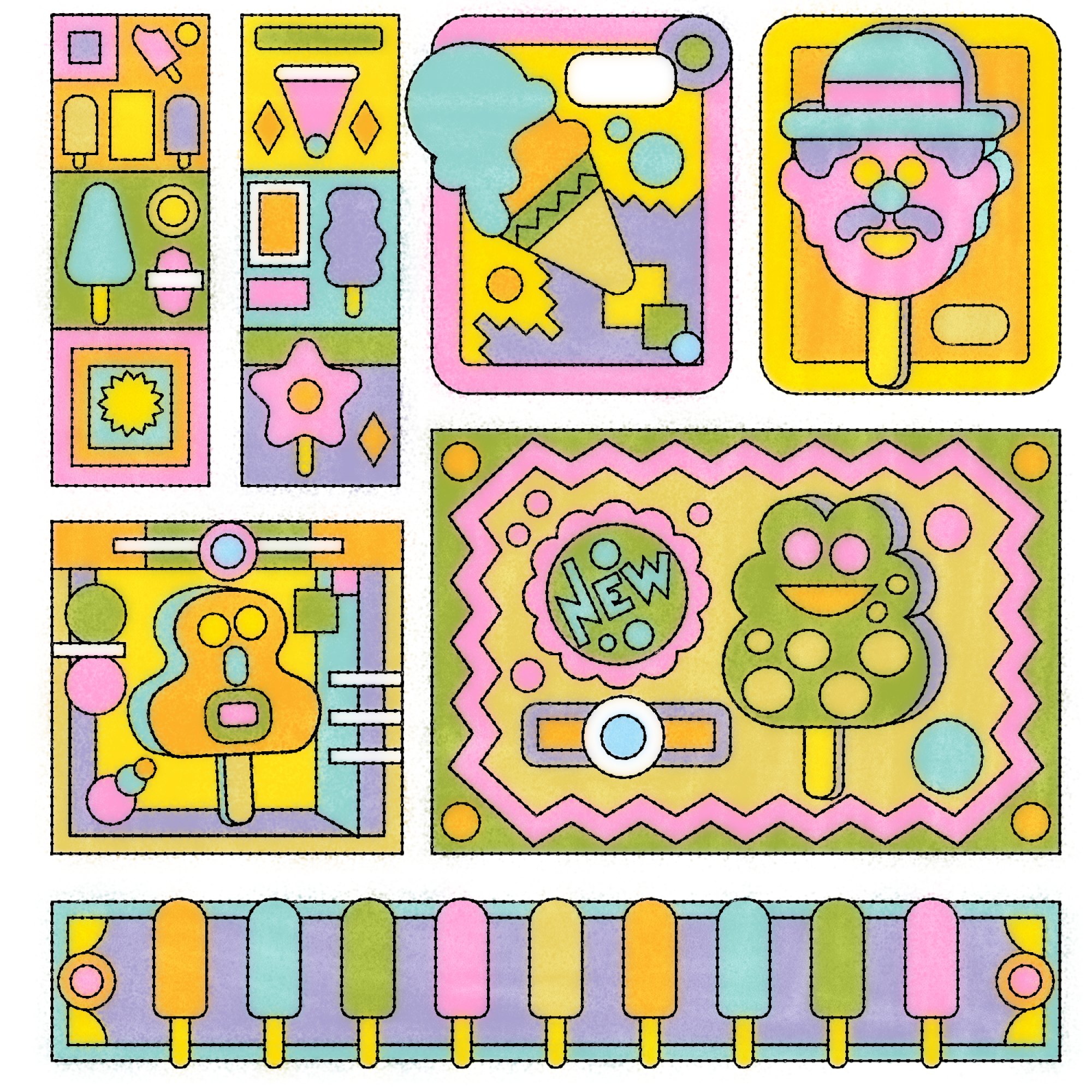
Gómez immigrated to the United States from Ixtapan de la Sal, Mexico, with one goal in mind: Earn enough money to be able to return to his family and provide a better life for them.
“I store a lot of hope in paletas,” said Gómez. “I want to build a house in Mexico. Right now, I don’t have a nice house. I have a house made out of cement blocks. And here, I walk, I work, to make a home [in Mexico]. I will buy a ranch with goats, cows and horses. I will buy a car. Many things are possible with paletas.”
His paleta journey didn’t begin in Los Angeles but in Chicago, where he bounced around different paleta vending companies like Paleteria Juarez and Las Delicias de Michoacan. In Chicago, he said, he could only sell his paletas for $1.50. So leaving new friends in the business behind, he packed his things and set off for Los Angeles, where he could sell his paletas for as high as $3 or $4.
As Gómez fixes the sleeve of his red and white checkered button-down, two children who seem to be siblings rush up to his paleta cart. The girl, no older than 5, counts the dollar bills in her hands and orders a pineapple paleta. She nudges her younger brother to speak.
“Una paleta de sandía,” he says. He’ll have watermelon. A couple yards away, two adults smile and point at the young siblings. The proud parents.
For young kids, their first time paying for an item without the presence of a parent is a sort of rite of passage. Handling money, talking to strangers and learning the niceties of social interaction are crucial lessons for a child to step into their own and develop confidence. And each of these lessons is put into action when parents send their children up to the ice cream man alone, with only a few crinkly dollar bills and a pat on the back to carry them through.
Gómez waits patiently as the girl whispers to her brother to get another dollar from their mom and dad. Once the boy returns, Gómez hands the children their paletas with a napkin wrapped snugly around the packaging. With one push of his cart, he is off again, ringing his bells to catch the attention of the next customer.
Gómez says he never considered joining the fleet of catchy tune-playing ice cream trucks that circulate on the streets of Los Angeles. He does not have a driver’s license, and he prefers walking anyway. It calms him, he says.

The makings of ice cream memories
In the streets surrounding Exposition Park, there are at least three ice cream trucks that regularly circle the neighborhood. Anthony Anderson, 60, says that in his 30 years living here, he’s probably bought ice cream from them all. And all their predecessors.
Hunched over his walker, Anderson stands in the walkway of his one-story apartment building, looking on as the Elizabeth’s Ice Cream truck draws a small crowd. His neighbor orders jalapeño-dotted chili cheese hot Cheetos for herself, and brings Anderson a large cup of soft serve.
From burger joints to artisan ice cream parlors, where to find the best soft serve in Los Angeles, whether new or nostalgic.
With major recent developments in the area such as USC Village, BMO Stadium and the upcoming Lucas Museum of Narrative Art, what were once family homes in Exposition Park have become sterile student apartment buildings. “There’s been some changes,” Anderson concedes. One thing that hasn’t changed? His favorite treat from the ice cream truck — a sundae filled with vanilla soft serve and ribbons of chocolate syrup.
“I do it for the kids,” Anderson says, as a father holding his daughter hands him a few dollar bills — payback for money Anderson lent him to buy her an ice cream. He waves to her and says, “Bye, little mama.”
“I put myself in their shoes. I’m a kid,” he says.
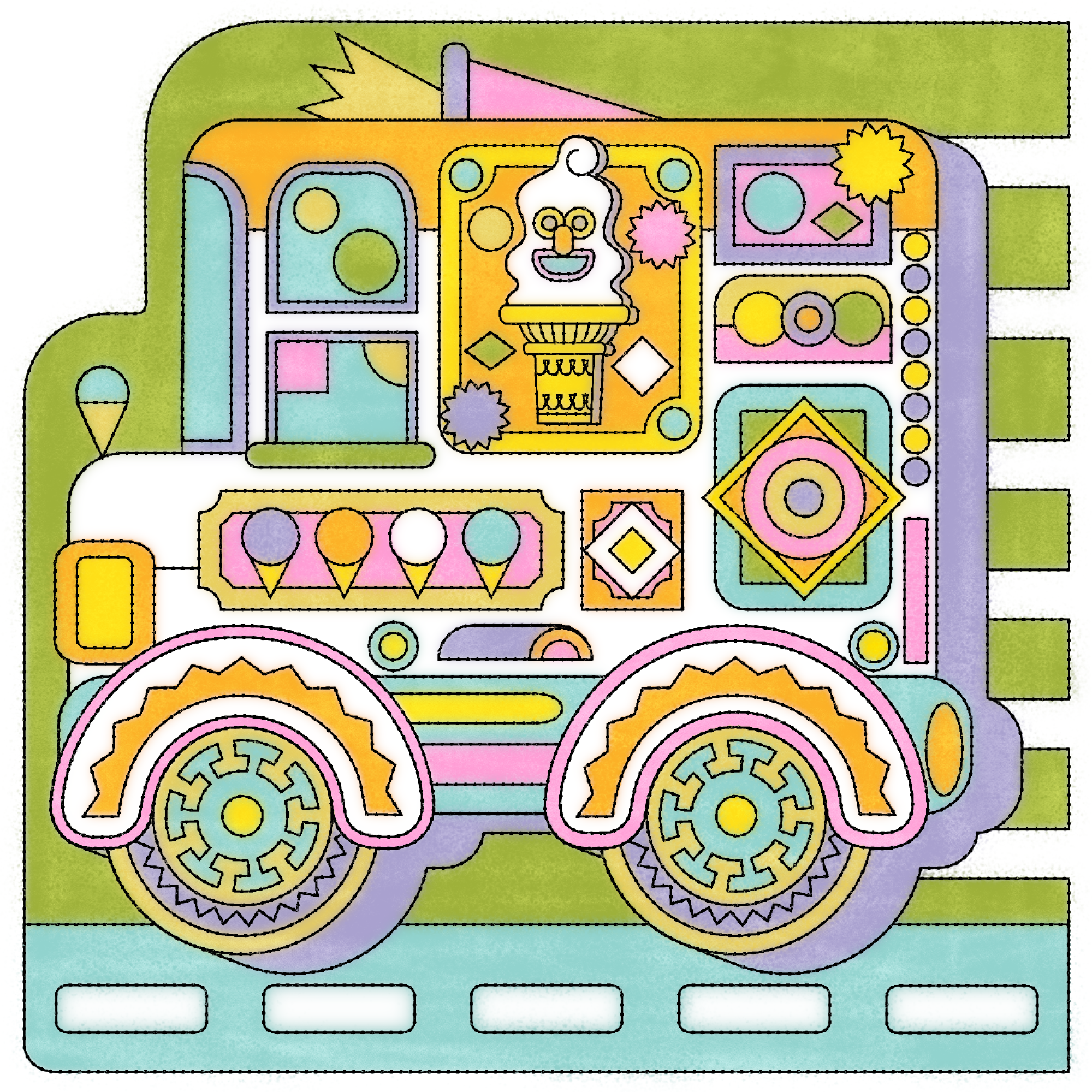
A few doors down, Patricia Wynn, 48, isn’t as moved by the rusty chimes of the ice cream truck as she once was. An L.A. native, Wynn remembers “waiting for [the] ice cream truck to come around so that we didn’t have to walk to the store.” Now that she has three children of her own and strives to eat clean, Wynn avoids them, although she acknowledges that “[ice cream trucks] play a significant role in the lives of people who visit them frequently.”
Among them would be Wynn’s son Jalen Robinson, 19, who in middle school used what little allowance he’d get from Wynn’s mother, his grandmother, to flag down the local ice cream truck almost every day.
“I was spoiled,” he admits.
Before the truck started coming around, Robinson and his peers would clamor after school to get snacks from a parent who would sell snacks from his pick-up truck. But the ice cream truck, ran by a man named Alex, swiftly took that business.
“One day, the ice cream man just seen [sic] us all just standing outside. Ever since then, he started posting up right after we got out of school,” Robinson said, describing instances where Alex would let Robinson and his friends pay him back when they didn’t have enough money. “The best snacks, great pricing ... He was that guy.”
Alex even updated his truck to meet the times.
“I really don’t carry cash,” Robinson says. “But Alex? Alex takes Apple Pay. Kids would be like, ‘We only got cards.’ When I tell you he pulled out that little reader. That is so tough.”

American dreams made of ice cream
Ice cream brought Patty Luna, 55, to America. Twenty-eight years ago, when an emergency forced a move from Mexico City, Luna called a friend who had told her that if she ever came to the U.S., they’d help her enter the ice cream truck business.
“I didn’t know how to drive,” Luna recalls with a laugh. “I had to start learning how to drive right away.”
Shortly after moving to Chino Hills and renting an ice cream truck, Luna met Eddy Estevez, 50, now her husband; he was then working at a hotel while also renting his own ice cream truck. The pair pooled their money to buy their two trucks and began establishing their route, employing the rigorous standards of a mail carrier.
SueEllen Mancini had been struggling with mental health issues. A move to L.A. and a new ice cream machine made it all click. Sad Girl Creamery was born.
“We started by driving around every single day, no matter what,” Luna says. “Hot, rainy, cold or even sick, we were driving every single day. And when we had our kids, they were with us the entire time, from my pregnancy until they were in high school.”
Branding themselves as Barney’s Ice Cream Truck, Luna and Estevez built a loyal customer base, but the unpredictable nature of ice cream trucks meant they never knew how much they were going to make on any given day. Desiring more guaranteed income, a decade ago Luna enrolled in classes with the L.A. chapter of the National Latina Business Women Assn.
“That’s where we learned how to register our business and all of the licenses we needed to apply for,” Luna says. The couple created business cards and reached out to local schools and law enforcement. Soon, they were booking birthday parties and company events and getting requests from after-school programs and sports teams. They still patrol the streets of Chino and will go as far as Ontario and Montclair when summoned, but special events now provide the bulk of the truck’s income.
“We still go out every day, but now we know exactly where we’re going and what we’re going to make,” says Estevez.
At it for 25 years, Luna and Estevez credit their success to their long-held customer relationships. “During the pandemic, people would call us and we’d serve them outside,” Luna recalls. “Everyone on the cul-de-sac would come out and it was amazing to see people laughing and having fun. It was just a small treat. Nothing more than an ice cream or a candy, but it was a moment to forget about all of the stress.
“They’ve known us for a long time,” she adds. “They know when they see Barney’s Ice Cream Truck that it’s a family business.”
The interview with Pedro Gómez was conducted in Spanish and translated, with answers edited for clarity.
More to Read
Eat your way across L.A.
Get our weekly Tasting Notes newsletter for reviews, news and more.
You may occasionally receive promotional content from the Los Angeles Times.

